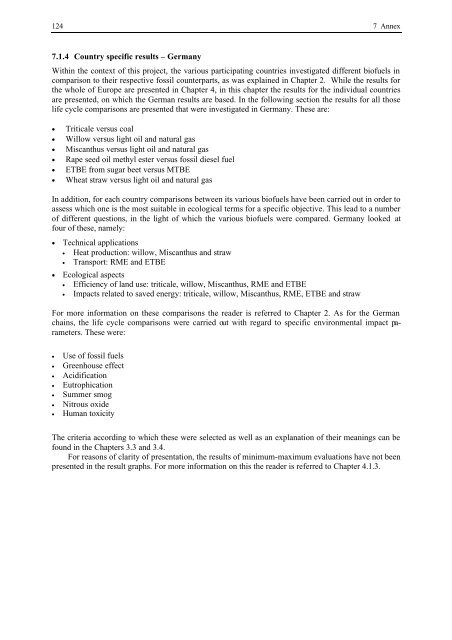BIOENERGY FOR EUROPE: WHICH ONES FIT BEST?
BIOENERGY FOR EUROPE: WHICH ONES FIT BEST?
BIOENERGY FOR EUROPE: WHICH ONES FIT BEST?
Create successful ePaper yourself
Turn your PDF publications into a flip-book with our unique Google optimized e-Paper software.
124 7 Annex<br />
7.1.4 Country specific results – Germany<br />
Within the context of this project, the various participating countries investigated different biofuels in<br />
comparison to their respective fossil counterparts, as was explained in Chapter 2. While the results for<br />
the whole of Europe are presented in Chapter 4, in this chapter the results for the individual countries<br />
are presented, on which the German results are based. In the following section the results for all those<br />
life cycle comparisons are presented that were investigated in Germany. These are:<br />
• Triticale versus coal<br />
• Willow versus light oil and natural gas<br />
• Miscanthus versus light oil and natural gas<br />
• Rape seed oil methyl ester versus fossil diesel fuel<br />
• ETBE from sugar beet versus MTBE<br />
• Wheat straw versus light oil and natural gas<br />
In addition, for each country comparisons between its various biofuels have been carried out in order to<br />
assess which one is the most suitable in ecological terms for a specific objective. This lead to a number<br />
of different questions, in the light of which the various biofuels were compared. Germany looked at<br />
four of these, namely:<br />
• Technical applications<br />
• Heat production: willow, Miscanthus and straw<br />
• Transport: RME and ETBE<br />
• Ecological aspects<br />
• Efficiency of land use: triticale, willow, Miscanthus, RME and ETBE<br />
• Impacts related to saved energy: triticale, willow, Miscanthus, RME, ETBE and straw<br />
For more information on these comparisons the reader is referred to Chapter 2. As for the German<br />
chains, the life cycle comparisons were carried out with regard to specific environmental impact parameters.<br />
These were:<br />
• Use of fossil fuels<br />
• Greenhouse effect<br />
• Acidification<br />
• Eutrophication<br />
• Summer smog<br />
• Nitrous oxide<br />
• Human toxicity<br />
The criteria according to which these were selected as well as an explanation of their meanings can be<br />
found in the Chapters 3.3 and 3.4.<br />
For reasons of clarity of presentation, the results of minimum-maximum evaluations have not been<br />
presented in the result graphs. For more information on this the reader is referred to Chapter 4.1.3.

















